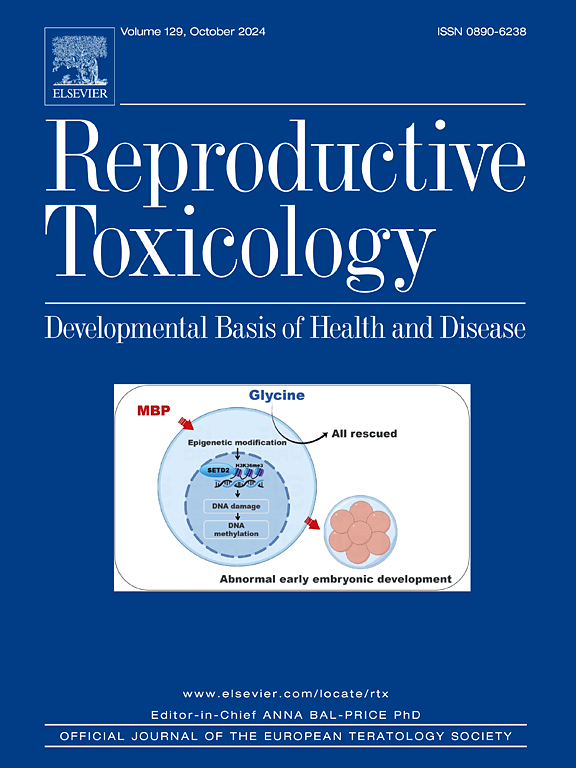Investigating the protective role of Astragalus polysaccharides against fluoride-induced testicular injury via network pharmacology, molecular docking, and in vivo experiments
IF 2.8
4区 医学
Q2 REPRODUCTIVE BIOLOGY
引用次数: 0
Abstract
Objective
This study aimed to investigate the protective effects of Astragalus polysaccharides (APS) against sodium fluoride (NaF)-induced testicular damage and to provide a theoretical basis for developing natural strategies to mitigate fluoride-induced reproductive toxicity.
Methods
Network pharmacology was employed to identify potential targets and pathways of APS in treating fluoride-induced testicular injury. Molecular docking was used to assess the binding affinity between APS active compounds and core targets. An in vivo rat model was established to evaluate testicular index, fluoride accumulation, and histopathological changes. Oxidative stress markers including SOD, CAT, GSH, and MDA were measured. Immunohistochemistry was performed to assess blood–testis barrier integrity and the expression of key targets (AKT1, ESR1, CASP3).
Results
Network pharmacology identified 34 potential APS targets, enriched in apoptosis, PI3K-Akt, and IL-1B signaling pathways. Molecular docking revealed strong binding affinity of APS components to core targets. APS significantly improved NaF-induced reductions in testicular index (p < 0.01) and fluoride accumulation (p < 0.05), alleviated seminiferous tubule atrophy and mitochondrial swelling, enhanced SOD, CAT activities and GSH levels (p < 0.01), and reduced MDA levels (p < 0.01). Moreover, APS upregulated CLDN1, ZO-1, and Occludin expression to repair the blood–testis barrier. Abnormal expression of AKT1, ESR1, CASP3, and HSP90AA1 was reversed by APS (p < 0.01).
Conclusion
APS mitigates fluoride-induced testicular toxicity via multi-target regulation of oxidative stress and blood–testis barrier pathways, offering a novel therapeutic approach for fluoride-related reproductive damage.
通过网络药理学、分子对接和体内实验研究黄芪多糖对氟化物致睾丸损伤的保护作用
目的探讨黄芪多糖(Astragalus polysaccharides, APS)对氟化钠(NaF)致睾丸损伤的保护作用,为制定减轻氟化钠致生殖毒性的天然策略提供理论依据。方法采用网络药理学方法,研究黄芪多糖治疗氟致睾丸损伤的潜在靶点和通路。采用分子对接的方法评估黄芪多糖活性化合物与核心靶点的结合亲和力。建立大鼠体内模型,评价睾丸指数、氟化物积累和组织病理学变化。测量氧化应激标志物,包括SOD、CAT、GSH和MDA。采用免疫组化方法评估血睾丸屏障完整性和关键靶点(AKT1、ESR1、CASP3)的表达。结果网络药理学鉴定出34个潜在的APS靶点,富集于凋亡、PI3K-Akt和IL-1B信号通路。分子对接显示APS组分对核心靶点具有较强的结合亲和力。黄芪多糖显著改善了naff诱导的睾丸指数(p <; 0.01)和氟积累(p <; 0.05)的降低,减轻了精小管萎缩和线粒体肿胀,提高了SOD、CAT活性和GSH水平(p <; 0.01),降低了MDA水平(p <; 0.01)。此外,APS上调CLDN1、ZO-1和Occludin的表达以修复血睾丸屏障。APS可逆转AKT1、ESR1、CASP3和HSP90AA1的异常表达(p <; 0.01)。结论黄芪多糖通过多靶点调控氧化应激和血睾丸屏障通路减轻氟化物引起的睾丸毒性,为氟相关生殖损伤的治疗提供了新的途径。
本文章由计算机程序翻译,如有差异,请以英文原文为准。
求助全文
约1分钟内获得全文
求助全文
来源期刊

Reproductive toxicology
生物-毒理学
CiteScore
6.50
自引率
3.00%
发文量
131
审稿时长
45 days
期刊介绍:
Drawing from a large number of disciplines, Reproductive Toxicology publishes timely, original research on the influence of chemical and physical agents on reproduction. Written by and for obstetricians, pediatricians, embryologists, teratologists, geneticists, toxicologists, andrologists, and others interested in detecting potential reproductive hazards, the journal is a forum for communication among researchers and practitioners. Articles focus on the application of in vitro, animal and clinical research to the practice of clinical medicine.
All aspects of reproduction are within the scope of Reproductive Toxicology, including the formation and maturation of male and female gametes, sexual function, the events surrounding the fusion of gametes and the development of the fertilized ovum, nourishment and transport of the conceptus within the genital tract, implantation, embryogenesis, intrauterine growth, placentation and placental function, parturition, lactation and neonatal survival. Adverse reproductive effects in males will be considered as significant as adverse effects occurring in females. To provide a balanced presentation of approaches, equal emphasis will be given to clinical and animal or in vitro work. Typical end points that will be studied by contributors include infertility, sexual dysfunction, spontaneous abortion, malformations, abnormal histogenesis, stillbirth, intrauterine growth retardation, prematurity, behavioral abnormalities, and perinatal mortality.
 求助内容:
求助内容: 应助结果提醒方式:
应助结果提醒方式:


